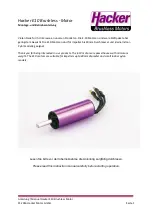
In case the engine does not stop.
Hold the rotor head, and pinch the silicone tube to
stop the fuel supply. If it still does not stop, pull off the
fuel tubing from the carburetor. It is necessary to
readjust the throttle linkage so that the carburetor
rotor is fully closed when the throttle stick and throttle
trim on the transmitter are fully pulled Down.
Stopping the engine
Fully pull down the throttle trim on the transmitter.
Starting
Connect the battery to the glowplug and start the
engine by applying the starter. When started,
switch off the starter and withdraw the starting
shaft after making sure the rotation of the starter
shaft stops.
8.
9.
NOTE:
If the throttle response is poor or the engine
stops due to a temporarily over-rich mixture im-
mediately after the engine is started, pinch the
fuel line for one or two seconds until the engine
r.p.m. increase and the engine runs steadily.
Reminder!
Never touch, or allow any object to
come into contact with, the rotating ro-
tor.
All internal-combustion engines benefit, to some
degree, from extra care when they are run for the first
few times known as running-in or breaking-in.
This is allows the working parts to mate together
under load at operating temperature.
However, because O.S. engines are made with the
aid of the finest modern precision machinely and from
the best and most suitable materrials, only a very
short and simple running-in procedure is required and
can be carried out with the engine installed in the
model. For the first few flights with a new engine i.e.
while the engine is being run-in set the needle-
valve for a slightly rich mixture not excessively rich
as this may result in poor throttle response and cause
the engine to stope. About one-quarter turn open
from the nomal setting will usually suffice.
RUNNING-IN ("Breaking-in")
14
















































